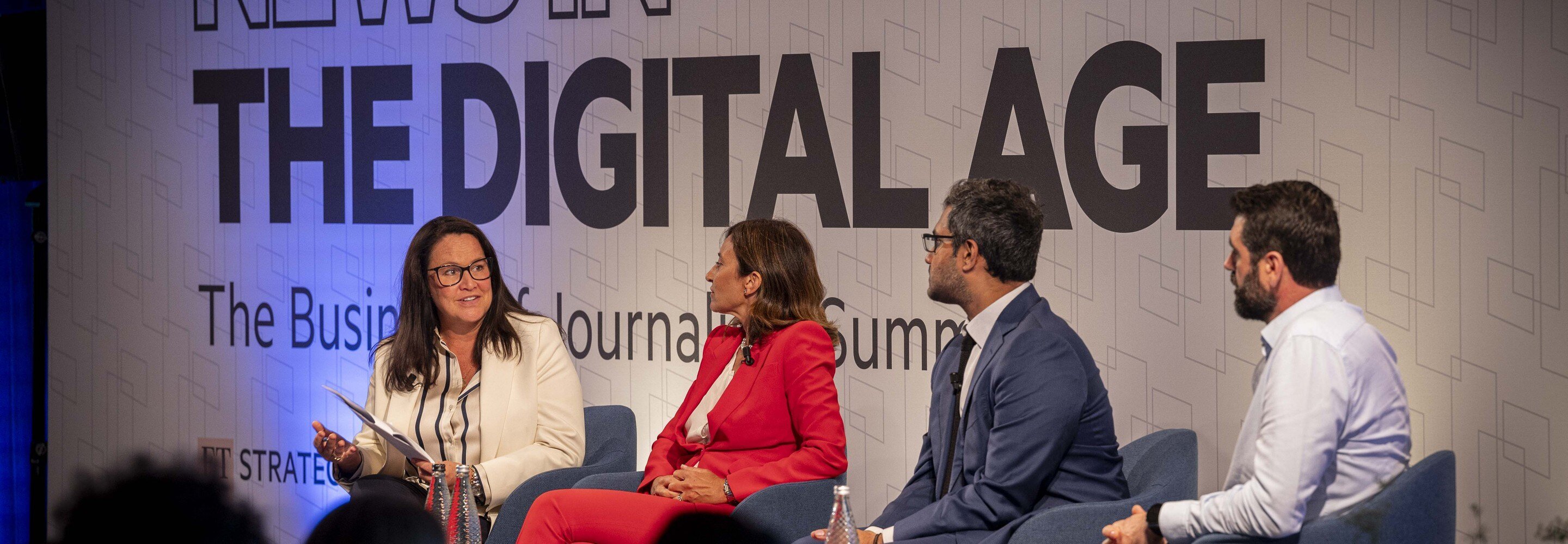
With macro factors influencing news media, from economic headwinds to news avoidance or technological disruption, publishers need to think creatively to innovate in a changing landscape. We know direct reader relationships continue to be paramount, and the importance of knowing where to invest - with finite resources - can be crucial.
In our first panel of the day, we saw Mirja Cartia d'Asero, CEO of Il Sole 24 Ore, Arun Venkataraman, Global Research & Insights Lead, Google News Programs, Google and Styli Charalambous, CEO & Co-Founder, Daily Maverick presenting their views on how financial sustainability can be addressed in the industry. FT Strategies Director, Lisa MacLeod, moderated the session.
News in the Digital Age 2024 hosted by FT Strategies and the Google News Initiative
Digital transformation and engaging the next generation
Mirja Cartia d'Asero, CEO of Il Sole 24 Ore, Italy's leading financial newspaper, explained why tackling the fast-moving digital economy and thinking about the next generation of readers is “the path to innovation and sustainability” of a news business.
“Engaging the next generation and innovation is the passport to the future. Without navigating the next generation, we are losing this next cycle [of digital revolution]. We overcame the PC revolution in the eighties, the internet revolution in the 2000s, now the AI revolution is coming for everyone, media especially. We need to act quickly to master AI and not be mastered by AI”.
“Our daughters and sons don’t read the newspaper. Their attention spans are very different than [ours were].”
She discussed the need for legacy brands to quickly adapt to digital-first models, suggesting they “first [tackle] changing management’s mindset” before getting to know your customers “needs and desires” and to continue investing in their user experience. “Quality will attract paying readers”.
Highlighting the Next Gen News study, Arun Venkataraman, Google, agreed that our focus on future readers and how they engage with news is key, noting their preferences on social media, formats, and empowering journalism from individuals, rather than organisations was worth paying close attention to.
The Daily Maverick, a South African public information news outlet, uses ‘engaged journalism techniques’ to serve their audience, which is made up members who can volunteer to pay, says their CEO, Styli Charalambous.
News industry ‘Kodak moment’ or market failure?
But have the external, macro factors effecting the news industry overtaken whatever efforts we make to address sustainability internally, and have we reached a point of market failure, Charalambous mused.
“A few publishers around the world are doing really well, but for the rest of us it’s a really tough space. We need to ask ourselves are we at market failure, or is this our Kodak moment”.
Considered the ‘most thoughtful CEO’ our moderator has ever encountered, Charalambous called for publishers and societies to collaborate on a local ‘package of laws and policy measures’ that could help reset the market context for public interest news outlets. He noted how tax rebates could be used to support people willing to pay for news, and that there is already a precident for these types of policy changes in Africa, where the Daily Maverick operates.


News in the Digital Age 2024 hosted by FT Strategies and the Google News Initiative
How do we approach financial sustainability in news?
Drawing on his work on the News Sustainability Project, Arun Venkataraman, Google, said we can start to think about our company’s news sustainability by assesing effort and performance against these four questions:
- Do you have differentiated product with engaged audience?
- Are you moetising that engagement effectively wth a diversified revenue strategy?
- Do you have the foundations to operate effectively and evolve over time as your audiences and market change?
- What are your financial indifcators eg do you have healthy cash flow and profit margins?
He identified three themes from the project, which saw (anonymised) responses from over 750 publishers:
- The importance of diversified revenue strategy, with four or five streams being optimum
- The importance of first party data, noting the high correlation between percentage of readers logged in and profitability and sustainability readiness
- The direct correlation between profitability and sustainability readiness, businesses in a leading position operate steadily and create space to invest in research and set long term goals
The full report from the project will be published later this year.
What do we start doing and what do we stop doing?
The panel rounded up by offering their advice on how to remain agile, and future-focussed by prioritising brand quality and reader trust, investing in people and innovation, and by eliminating distractions like operating issues, debts and inefficiencies when navigating the evolving news landscape.
At FT Strategies, we work with news and media organisations globally, helping them address strategic challenges, drive sustainable growth and innovate using AI, technology and data. If you would like to chat about any of these topics with our expert consultants, please get in touch.




